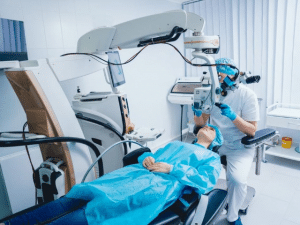Epi-LASIK
Epi-LASIK in Iran
Best epi-LASIK clinic in Iran
Best epi-LASIK hospital in Iran
More than 40,000 Iranian and foreign patients are going under Epi-LASIK in Iran each month. epi-LASIK in Iran is on top of the middle-east regarding its skilled specialists and surgeons. Here are the best clinics for epi-LASIK in Iran:
- Noor clinic
- Negah clinic
Epi-LASIK cost in Iran
There is a significant difference between the cost of epi-LASIK in Iran and other countries. The most important factors for the low price of it in Iran are:
- A large number of epi-LASIK clinics in Iran.
- A large number of applicants for epi-LASIK in Iran
Epi-LASIK cost in Iran varies depending on the cataract surgery and the hospital. An average cost of cataract surgery in Iran is $
Epi-LASIK cost in Iran in comparison with other countries
This surgery costs $2.800 in the U.S., $2.500 in Europe, $1.500 in Thailand and $800 in Turkey.
Best epi-LASIK surgeon in Iran
One of the most important factors for choosing a good surgeon at epi-epi-LASIK in Iran is the doctor has done many epi-LASIK surgeries.
You can find the best doctors for epi-LASIK in Iran in our website by following their experiences.
Why should you travel to Iran for a epi-LASIK?
Many patients travel to Iran for epi-LASIK. One of the reasons for this matter is Iranian specialists and ophthalmologists who have high surgery success rates.
- Low cost of epi-LASIK in Iran
- Low cost of accommodation in Iran
- Well experienced doctors
- The high number of epi-LASIK in Iran
Diagnostic and surgical centres accordant with today’s European standards are performing the highest quality operations in Iran. Another reason for epi-LASIK in Iran is its lower cost compared to other countries.
How long should I stay for epi-LASIK in Iran?
About Epi-LASIK

Many people around the world who are nearsighted, farsighted, or have astigmatism use Epi-LASIK eye surgery as a long-lasting solution to restore diminishing vision. It helps people to have an even more beautiful, shiny face by getting rid of all kinds of glasses and it’s side effects on the face. It is very similar to LASIK and LASEK, but here the flap created in the cornea is thinner than a LASIK flap. This can be an advantage for patients with thinner-than-normal corneas. Unlike LASEK, an alcohol solution typically is not applied to the eye in epi-LASIK to loosen epithelial cells from the underlying corneal stroma. Some doctors find this reason good enough to prefer epi-LASIK over LASEK since alcohol is toxic to epithelial cells and can increase healing time after the procedure. Many people around the world who are nearsighted, farsighted, or have astigmatism use Epi-LASIK eye surgery as a long-lasting solution to restore diminishing vision. It helps people to have an even more beautiful, shiny face by getting rid of all kinds of glasses and it’s side effects on the face. It is very similar to LASIK and LASEK, but here the flap created in the cornea is thinner than a LASIK flap. This can be an advantage for patients with thinner-than-normal corneas. Unlike LASEK, an alcohol solution typically is not applied to the eye in epi-LASIK to loosen epithelial cells from the underlying corneal stroma. Some doctors find this reason good enough to prefer epi-LASIK over LASEK since alcohol is toxic to epithelial cells and can increase healing time after the procedure.
Recommended for
- people who have thin corneas, with insufficient tissue for a good LASIK flap
- people who have professions or hobbies that increase the chance of being hit in the eye
Before Epi-LASIK
Before this eye surgery, the patient will meet with an ophthalmologist to go through medical history taking and eyes will be fully examined; Likely initial tests include measuring corneal thickness, refraction, corneal mapping, eye pressure, and pupil dilation will be taken.
During Epi-LASIK
The Epi-LASIK procedure uses a particular device resembling a microkeratome. It uses an oscillating blunt plastic blade rather than a sharp metal one to incise the epithelium just below the basement membrane. The epithelial separator creates a thin, hinged epithelial sheet similar to that made in LASEK but without the use of potentially toxic alcohol.
Recovery
Vision probably will not be perfect immediately, but In three days, many patients get 20/40 or even 20/20 vision. As with any laser eye surgery, after Epi-LASIK, it is very important to follow the surgeon’s instructions exactly, because the quality of the final vision that patients achieve is affected by how well corneas heal. Patients may experience some discomfort after the procedure, and it is usually manageable with OTC painkillers. Patients should be careful and not rub their eye. The surgeon may place a transparent protective shield over the eye to help protect the cornea as it heals.
FAQ
Epi-Lasik is a type of laser eye surgery that uses a special blade to create a thin flap on the cornea, allowing the surgeon to reshape the underlying tissue with a laser.
Yes, epi-Lasik is a safe and effective procedure when performed by a qualified and experienced surgeon in Iran. The country has a strong reputation for medical tourism and offers high-quality healthcare services.
Most patients can return to work and normal activities within a few days after epi-Lasik surgery in Iran. However, it may take several weeks for vision to fully stabilize and for any discomfort or dryness to subside.